Church Farm Industrial School for Boys, East Barnet, Hertfordshire
The Church Farm Industrial School for Boys was founded in 1860 at East Barnet, by Major (later Lieutenant-Colonel) W.J. Gillum. It was originally established as a farm branch of the Boys' Home Industrial School, which was opened in 1858 on Euston Road in London by Major Gillum's brother-in-law, George William Bell. The superintendent of the London School was Ebenezer Rayment, who had served as a sergeant with Gillum. The Major bought a farmhouse and fifty acres of land at the west side of Church Hill Road. He also had a home built for himself at the north of the site, known as Church Hill House. The bulk of the site was rented at a nominal rent to the committee formed to run the new institution which opened on November 20th, 1860, in the existing farm buildings where initially up to 40 boys could be housed.
On June 4th, 1863, the establishment was certified as an Industrial School in its own right, allowing it to receive boys' sentenced by the courts to a period of detention. Church Farm subsequently began to operate independently of the Euston Road School.
In 1866, the superintendent of the School, Mr Pinson, was succeeded by Mr Holloway, assisted by his daughter who taught the younger boys. The average number of inmates at the School was then 32, of whom 11 were under detention.
Considerable alterations and additions were being made to the premises in 1866-68, including a dining-room, school-room, workshops, and a kitchen with a small dormitory above. In 1868, an additional houses was erected with accommodation for about 30 boys. The School site is shown on the 1898 map below.
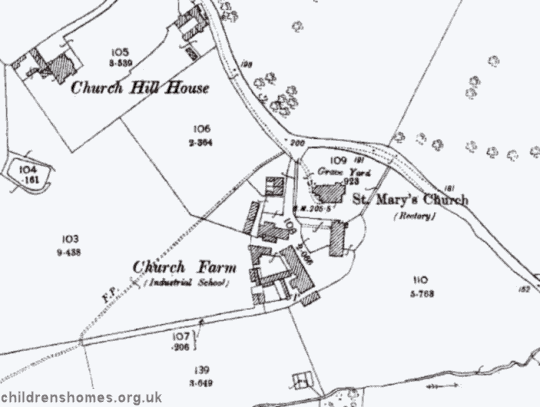
Church Farm Industrial School for Boys site, East Barnet, c.1898.
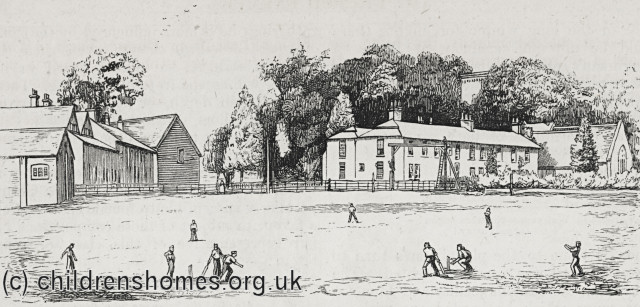
Church Farm Industrial School for Boys from the south-east, East Barnet, c.1888. © Peter Higginbotham
In the picture above, the original farmhouse is shown right of centre. Later additions are at the left.
In 1868, there was an outbreak of typhoid fever at the School caused by impure water being brought during a drought from a neighbouring brook for washing and cleaning purposes. A total of 21 boys were affected, together with 4 of the superintendent's children, one of the former dying and another suffering permanent brain damage.
In 1869, John Bowden and his wife Martha took over as superintendent and matron of the School. Martha was the daughter of Ebenezer Rayment, the aforementioned superintendent of the Boys' Home School. She continued in post until her death in 1885. John subsequently remarried, his new wife being Kate Louisa Francis.
The main activity on the farm at that time was dairy production. There was a large stock of cows being milked by the boys and the milk delivered to neighbourhood customers.

Church Farm Industrial School for Boys — milk round, East Barnet, c.1908. © Peter Higginbotham
As well as the dairy, the boys were trained in a variety of other work. In 1896, it was noted that 37 boys were occupied in farm work; 9 as house boys, including bakers; 14 in the needle room; 6 as tailors; 6 as shoemakers; and 6 in the wood-shed. A portion of the land was cultivated as a market garden.

Church Farm Industrial School for Boys — haymaking, East Barnet, c.1908. © Peter Higginbotham

Church Farm Industrial School for Boys — pig sty, East Barnet, c.1917. © Peter Higginbotham
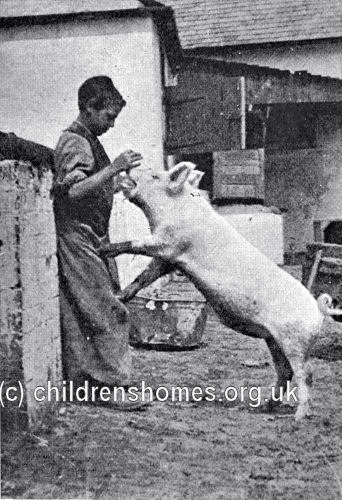
Church Farm Industrial School for Boys — feeding a pig, East Barnet, c.1917. © Peter Higginbotham
In 1888, the daily routine began with the boys rising at 5.30, then attending school until 7.45, when breakfast was served. Play followed until 9. Work went on in the house and on the farm until 10. Then from 10 to 12, there was school for the milk boys, house boys, and cow house boys while the others continued at their trades, or at work on the farm. At noon, those who had been engaged in active work returned to the school, joining those already there, when studies continued until 1. Dinner was then served, after which the boys played until 2. Work resumed until 5 in the house and on the farm. Gymnastics, drill or band practice were then allowed for an hour until supper was served. Play then continued until 8, then prayers were read and the boys were in bed shortly before 9.

Church Farm Industrial School for Boys — carpentry workshop, East Barnet, c.1908. © Peter Higginbotham
An 1897 report noted that the cricket and football field was used daily, and that the School had won 9 out of its 13 matches against outside teams. There was gymnastic apparatus on which instruction was given from time to time, together with military drill. The School had a library and pursuits such as the collection of plants, flowers and butterflies were encouraged. In the winter, entertainments such as lantern shows were organised, as well as concerts at which the boys sang. Boys with 'decent enough' parents were given annual leave to spend time with them. Visiting was also allowed at the School on Saturdays. Some of the boys had vegetable or flower plots, with prizes awarded to the best.
Once a year, on Whit Monday, all Old Boys, were invited to attend a festival at the school which included games and a concert. A cricket match took place between the Old Boys" and the 'Present' Boys.
In 1905, an open air swimming bath was built at the north west corner of the school buildings. An indoor swimming pool now occupies the location.

Church Farm Industrial School for Boys — swimming bath, East Barnet, early 1900s. © Peter Higginbotham
John and Kate Bowden remained in charge of the establishment until their retirement in June 1901, John having been in post for more than thirty years.
The School had a drum and fife band which gave performances at local events. Many band members subsequently took up careers as army bandsmen. A Cub Pack and Scout Troop were also formed at the School.
Further buildings were added to the School over the years, with a major at the south of the site in the mid-1920s. The school layout in 1936 is shown on the map below.

Church Farm Approved School site, East Barnet, c.1936.

Church Farm School from the north-west, East Barnet, c.1928. © Peter Higginbotham

Former Church Farm School from the north-west, East Barnet, 2014. © Peter Higginbotham
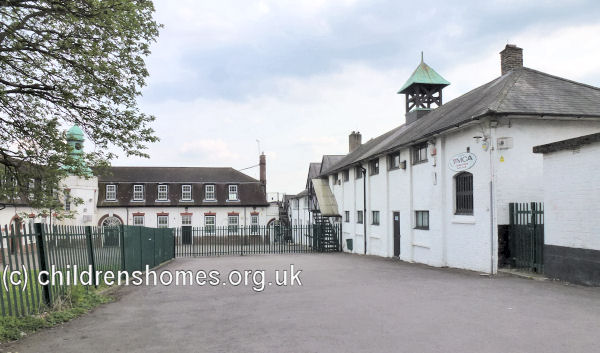
Former Church Farm School from the north, East Barnet, 2014. © Peter Higginbotham

Former Church Farm School from the west, East Barnet, 2014. © Peter Higginbotham
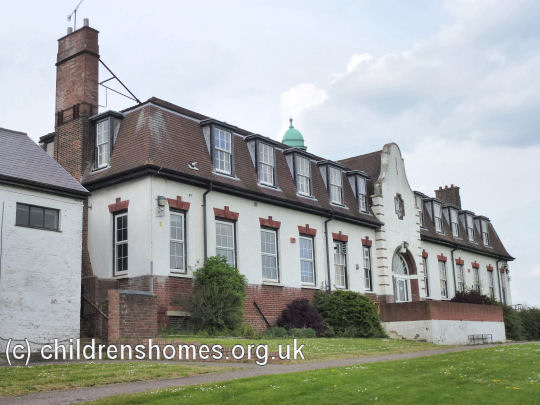
Former Church Farm School from the south-west, East Barnet, 2014. © Peter Higginbotham
In 1933, the establishment was redesignated as an Approved School, one of the new institutions established under the Children and Young Persons Act of 1933 to replace Reformatories and Industrial Schools. Church Farm was certified as an Intermediate Approved School for 105 boys aged 13 to 15. It was described as a suburban school giving training in dairy farming and carpentry. The headmaster in 1936 was Mr J.V. Cartwright.
In 1937, the School relocated to South Godstone, Surrey, and became the Court Lees Boys' Farm Home.
The East Barnet site was subsequently used to house a local school and a clinic. In more recent times it has formed the Oak Hill campus of the Mill Hill County High School.
Records
Note: many repositories impose a closure period of up to 100 years for records identifying individuals. Before travelling a long distance, always check that the records you want to consult will be available.
- Surrey History Centre, 130 Goldsworth Road, Woking, Surrey GU21 6ND. Has Photographs of the Home, some with boys (1926).
Census
Bibliography
- Higginbotham, Peter Children's Homes: A History of Institutional Care for Britain's Young (2017, Pen & Sword)
- Mahood, Linda Policing Gender, Class and Family: Britain, 1850-1940 (1995, Univeristy of Alberta Press)
- Prahms, Wendy Newcastle Ragged and Industrial School (2006, The History Press)
- Higginbotham, Peter Children's Homes: A History of Institutional Care for Britain's Young (2017, Pen & Sword)
- Hyland,Jim Yesterday's Answers: Yesterday's Answers: Development and Decline of Schools for Young Offenders (1993, Whiting and Birch)
- Millham, S, Bullock, R, and Cherrett, P After Grace — Teeth: a comparative study of the residential experience of boys in Approved Schools (1975, Chaucer Publishing)
Links
- None noted at present.
Except where indicated, this page () © Peter Higginbotham. Contents may not be reproduced without permission.


